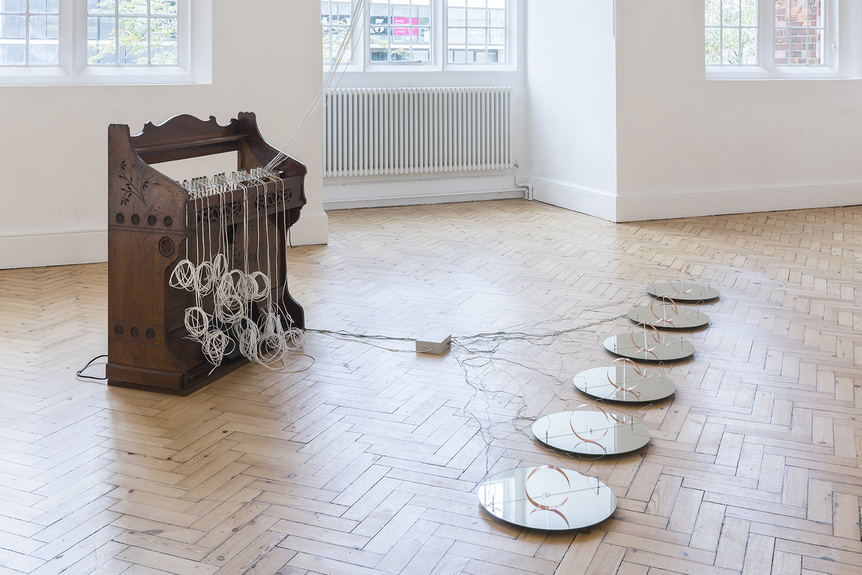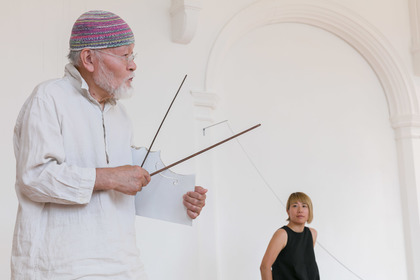
R
E
V N
E
X
T
Voluta: Recap of Yuko Mohri and Akio Suzuki’s Performance
Installation view of YUKO MOHRI’s “Voluta,” at Camden Arts Centre, London, 2018. Photo by Damian Griffiths. All images courtesy the artists and Camden Arts Centre.
The history of experimental music is a major reference for the work of installation artist Yuko Mohri. Her exhibition, “Voluta,” at London’s Camden Arts Centre, comprises a sprawling network of objects that vibrate with a life of their own—literally, in the case of a fish tank with speakers attached, which references Fluxus artist Nam June Paik’s new media work Video Fish (1975). Conceived as an audio-spatial composition that is specific to the Centre’s environment, Voluta’s (2018) score is left to non-human agents and chance to construct. Its title refers to the naturally occurring spiral shape that has been the basis of artistic creations across multiple cultures and disciplines. On the occasion of the show’s opening, renowned sound-art pioneer Akio Suzuki was invited to perform within the installation, elucidating the importance of sound to Mohri, as well as the rich heritage of experimental sound art.
Walking into the gallery for Suzuki’s performance was like entering a concert hall while the musicians were already tuning up. Hanging in the space as part of Mohri’s Voluta were a large set of window blinds that snapped and crackled periodically as an automatic mechanism rotated them. Mounted on the wall, two spoons moved by their own system of motors and gears, occasionally striking a small bell that hangs by a long thread. This chiming resonated with the vibrations of Mohri’s other devices placed around the floor, including a modified 1934 reed organ that pumps on its own, cueing us in to the antecedent of John Cage’s manipulation of instruments, as with his prepared pianos. In the background was the rumble of traffic along Finchley Road, just a few meters away from the gallery, the sound of which poured in through the open windows—an unavoidable measure against London’s heat wave. The constant drone punctured by sirens at times provided a counterpoint to the performance that increased the appreciation of Suzuki’s technical mastery, as from his simple instruments he produced sounds that dominated the space without electronic amplification. At other moments, Suzuki’s interest in the acoustic characters of different architectural spaces meant that the background sounds were folded seamlessly as found elements into his performance.
To begin, Mohri sat on a stool near the middle of the space while the audience was left to arrange themselves. There was a line of objects laid out on the ground in front of her, including two small stones and a mirror that Suzuki would use as an improvised instrument. These devices, meant for the performance, momentarily became an indistinguishable part of Mohri’s sculptures, particularly as one node of the installation, made up of magnets sitting on mirrors, was arranged nearby. Then, without drawing attention, Suzuki began to slowly circumambulate the gallery, holding what appeared to be tuning forks that chimed as he made his way to a position opposite Mohri. This was to gently guide the audience to attend to the ambient energy in the gallery, generated by Mohri’s installation and the anticipation of viewers.
AKIO SUZUKI and YUKO MOHRI, Voluta, live performance, at “Voluta,” Camden Arts Centre, London, 2018. Photo by Mark Blower.
Suzuki proceeded to pick up instruments from the floor, playing them in turn for a few minutes each. With a flute, he responded to the periodic ringing of the bell and the other sounds produced by Mohri’s works in what became an improvised jam session. Mohri sat passively for most of the performance, though expectations for an interchange between her and Suzuki built.
Next, Suzuki shifted his attention to a woodblock, which he used as a percussive instrument. Moving between the various elements of Mohri’s installation, he experimented with the different sounds that it produced around the space. A scrap of card was played with two sticks as a bow, producing an un-tuned howl that succeeded in drowning out the traffic. Two stones, when ground together by Suzuki, created a surprising variety of subtle notes, and for a time he stood near the fish tank as though the occupants needed to be included in the performance as collaborators. Rubbing a small mirror produced a screech that strained the nerves of the audience. After that, Suzuki played a stone with holes drilled into it as a mouth organ, building a range of audio qualities that recalled bird song and meditative chanting.
Finally, Mohri and Suzuki held between them one of Suzuki’s most well-known, custom instruments, the Analapos, which includes two metallic cylinders joined by a spring. The artificial hum that emanated from the device when strummed reminded me of the ethereal tone of the electronic instrument theremin, invented in 1920, and its soaring notes evoked the echo effects of a much larger, cathedral-like space. Witnessing the creation of these variegated sound effects was quite magical—the performance undoubtedly added to the animism of Mohri’s work—and as the event reached a climax, Suzuki’s gestures took on something of a shamanistic aspect. Mohri’s work includes homages to earlier sound artists, and having Suzuki interact with the exhibition was a brilliant expansion of its themes.
Akio Suzuki and Yuko Mohri’s performance was a part of the Mode Japan London program, curated by Ryuichi Sakamoto.
Yuko Mohri’s “Voluta” is on view at the Camden Arts Centre, London, until September 16, 2018.
To read more of ArtAsiaPacific’s articles, visit our Digital Library.









